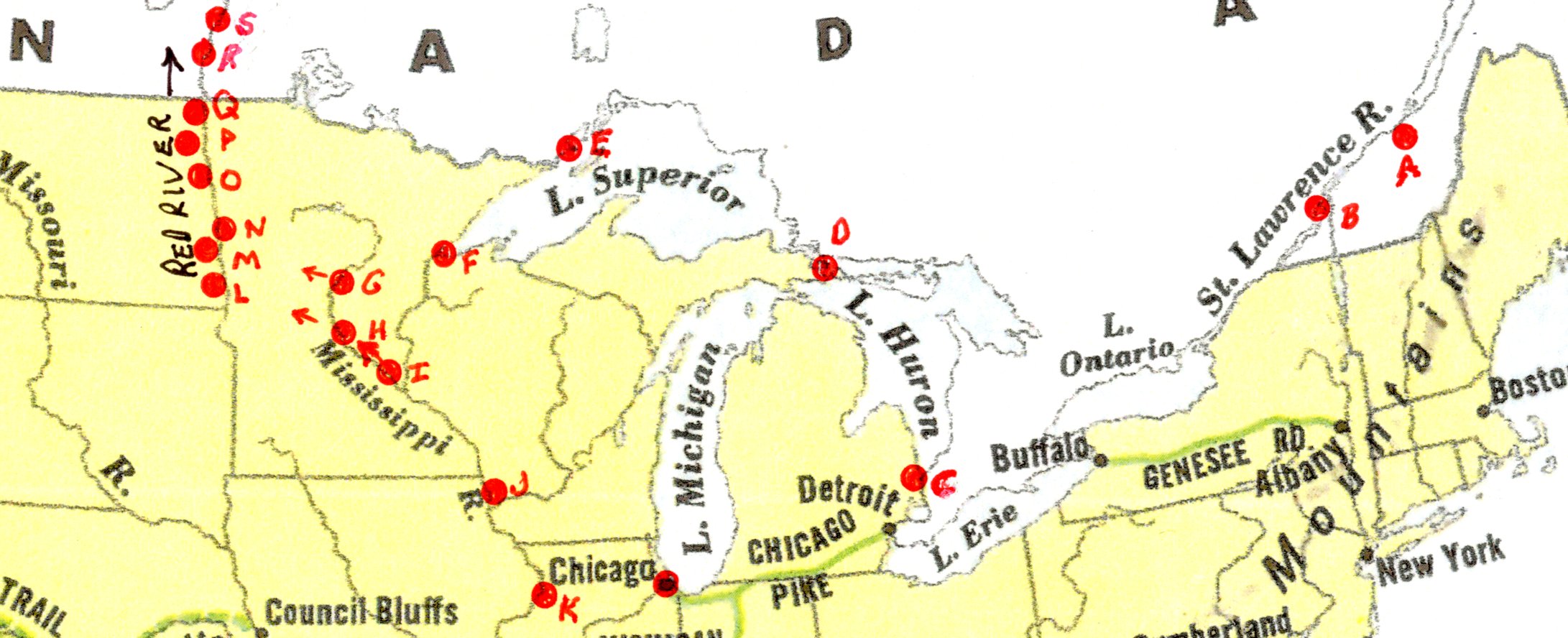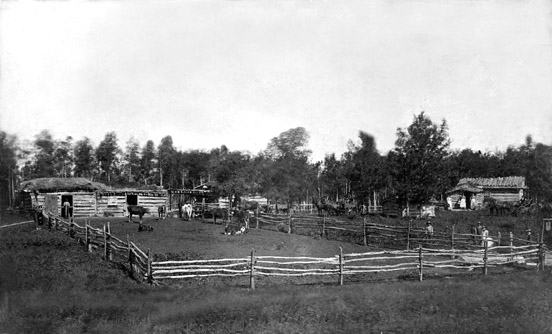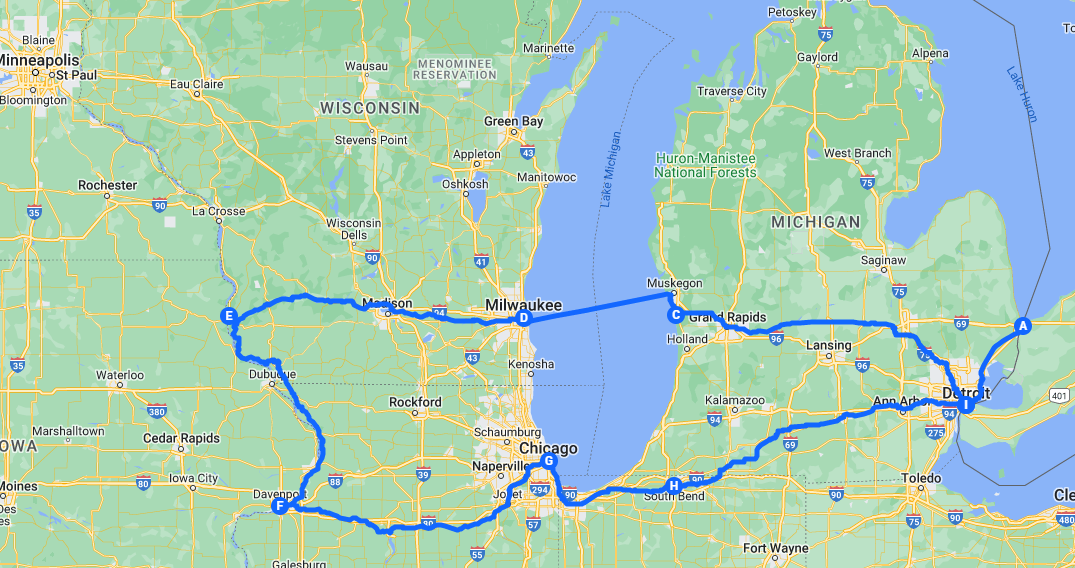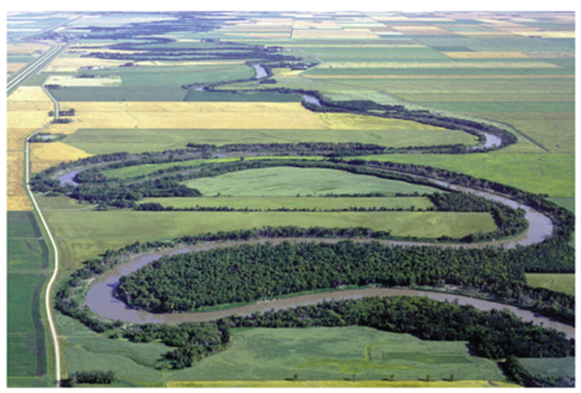Getting there…traveling from Quebec in the old days.
FOLLOWUP POST AT APRIL 28 HERE. Related post here.
PRENOTE: Comments section for this blog have been repaired and are again available to users. Today’s post relates to history of French-Canadians in this part of the world. Not directly related, but the Coleen Rowley talk about Leonard Peltier on Thursday is on-line and can be watched here. Two timely commentaries overnight: Joyce Vance on Mifepristone; Heather Cox Richardson on Earth Day. Check all of these out. Every single one of us are “politics”; the crucial “politicians”. Democracy demands that of all of us as citizens. It’s nobody else’s problem. Have a good weekend. We’re out of town till Wednesday.
*
Today (Friday), absent flooded roads or another heavy snowfall or etc., we were to give our friend Annelee a ride home to the Red River Valley, and one of the days I’d planned to drive further up the Valley to my French-Canadian dad’s growing up home area of Grafton, North Dakota. The trip had to be postponed: concern about possibly more snow and/or high water.
When we travel these days, my route is mostly interstate highway. But today I’m thinking back to the time in the 1850s when my ancestors began their move from rural Quebec (“A” on the map), ultimately taking, starting 1878, homesteads at Oakwood, near Grafton ND (“P”). (A pdf version of the map with legend is here: Transportation 1800s. This is a working draft, your input is invited).
Every family story is different, but what follows might help you in exploring your own family story, regardless of where they came from, or when. Getting here, for the pioneers, was not easy.

I live in suburban St. Paul MN (“I”), and have traversed the entire Quebec to Twin Cities to Winnipeg route at one time or another. From my home to Grafton ND is 371 miles; to St. Lambert QC, 1,148. Thus, the total trip back in those good old days was over 1,500 very difficult miles.
Exactly how one traversed those 1,500 miles depended on circumstances at the time. These varied greatly, and the travelers rarely kept records. So, when a Grandpa told his grandkid some generations back that he “ice-skated from Canada” to North Dakota, who’s to know? (This seemed implausible to me until cousin Remi related that some ancestors near froze and starved stranded in a frozen Lake Superior bay near Duluth in about 1870.)
The travel was by no means random. It was based on whatever was known and available at the time. Every story is unique.
*
Here are some of my picks of crucial mid-19th century locations facilitating or impeding migration from eastern Canada to todays midwest. See the map.
Take your pick of the stories, means of travel and routes used, if you’re one of the hundreds of thousands of Minnesotans with French-Canadian ancestry, and millions of others, some of whose ancestors might have travelled from the east to the midwest way back when….
“C” is Sarnia Ontario and Port Huron Michigan. The cities are on the opposite sides of the St. Clair River at the mouth of Lake Huron. Port Huron became a U.S. Port of Entry in 1857.
“D” is Sault Ste. Marie where locks made traversing into Lake Superior possible beginning 1855.
“K” is Rock Island IL, on the Mississippi, was reached by rail from Chicago in 1854, a truly major event encouraging migration into what is now Minnesota.
In 1867 the railroad reached St. Paul (“I”), and in 1872 it reached Fargo-Moorhead (“M“).
Before that, beginning about 1820, to 1872, oxcarts carried traffic from Red River area to St. Paul. St. Anthony Falls and other rapids stopped steamboat traffic at St. Paul. Steamboat travelers arriving at Duluth heading west in the 1870s, had to take a train to St. Paul – there was no direct route from Duluth to Fargo until later.
In 1859 steamboats began to ply the Red River of the North; the coming of the railroad to Fargo increased their impact. These were not pleasure boats, and the Red River was nowhere near the straight line it appears on a map. Georgetown MN, just north of Moorhead, benefitted from more water supplied by the Sheyenne River, which entered the Red a short distance upstream. Of course, the Red flows north, and this is the season of the year when water backs up behind the still frozen river further north. Spring is always interesting.
The traverse which seems most daunting, at least to my minds-eye, is the one from present day Thunder Bay (“E“) to Winnipeg (“S“). It was the Dawson Trail, hacked out of the wilderness about 1868-70.
In summary: back then travel was more than a minor adventure! There are fascinating histories easily searchable on the net.
*
Following are a couple of stories related about life and travel in those long ago days.
My cousin, Remi Roy, recently wrote about ancestral travel from the east to Manitoba, via Minnesota and Red River. Following are three separate snips from Remi’s nearly complete family history. I present them exactly as written. I simply take three separate snippets from recent e-mails for this mosaic.
Remi: My great great grandfather Hilaire Roy was born in Beaumont Quebec in 1829. Poverty stricken, he moved with his family including great grandfather Absolom Roy who was sixteen, to Fall River Massachusetts in 1872, where tens of thousands of Canadiens (French Canadians) were already. They all worked in cotton mills, even the younger children aged 12 and 8 (Willamene). in the worst sweatshops and densely populated tenement slum in America. A journalist wrote that “it would be an abuse to house a dog in such a place”
In 1876 the family moved to a Metis village, St Jean Baptiste, Manitoba [on the Red River a few miles north of the U.S.border] to homestead, after a 3-week dangerous journey through the Great Lakes. They were stranded for 8 days on the ice on the narrow Duluth Bay. Starving, they finally walked a great distance to shore.
The Metis helped them through the bitter winter that year in St Jean Baptiste. Willamene later married a Metis boy from the village and changed her name to Mary King (English version of Roy). One of her sons was killed in WW1. Absolom married and moved to Walhalla, North Dakota, once a Metis town, and then with his wife and 12 children, to Lampman [Sask] in 1903. In 1905 Hilaire came to Lampman after the death of Absolom and stayed a few years. He then moved back to Fall River sometime after 1911 to be with his brothers, quite a journey in those days for someone in their 80’s. He died there at the age of 88, in 1917. His family put up a beautiful headstone as Absolom’s family did in Lampman…
*
“It was more a convenient as well as a smoother journey from Eastern Canadian for settlers to take a Great Lakes steamer to the American side of the border, catch a train to St. Paul, proceed north to the railhead at Moorhead and then board a [Red River] steamer bound for Winnipeg”.
“The boat trip from Moorhead to Winnipeg occupied a couple of days and nights.” [another version, presented below, also from Remi, suggests a five day trip. Both versions are logical.].
“The nearest railroad (from Winnipeg) was at Moorhead on the Red River, 222 miles away. Its connection with the outer world was one, or possibly two, steamers on the Red River in the summer, and by weekly stage in winter.”
Ham, George H. Reminiscences of a Raconteur: Between the ’40s and the ’20s. The Musson Book Co Ltd Toronto, 1921 Distributed Proofreaders Canada (online). [Presumption the time period is 1840s to 1920s]
*
It seems that they considered the train trip from Sarnia to St Paul to be more arduous. It was 725 miles from Sarnia to St Paul by train,, It was a little longer from Sarnia to St Paul via the Great Lakes and Duluth. Judging from the fact that the train trip from Worcester, Mass to Sarnia took 4 days, the trip seems to have taken about the same time for both routes from Sarnia to St Paul…
“The boat trip took about five days and cost $19.00 for second class. The first large group to sail down the Red River from Minnesota to new homes in Manitoba was in 1874. “In 1876, with the aid of barges, a steamboat carried 423 Mennonites, 125 French Canadians, and 27 Scandinavians, all on one trip from St Paul to Manitoba”. Parts of the river were muddy, shallow and there were sharp bends. Hilaire and Absolom were on this boat.”
*
Dick: From my own family history which I compiled in 2010, “400 Years”, page 14: Fr. Joseph Goiffon, the legendary French Priest who nearly froze to death in a Dakota blizzard, and lived in Minnesota for near 60 years, “is said to have arrived in New York City from France October 12, 1857, and arrived in St. Paul November 7, 1857”. While Fr. Goiffon’s precise schedule for those first 26 days in the U.S. is not known, it is reasonable to assume that there was little time for activities other than traveling the approximately 1200 miles to St. Paul, then only a town in Minnesota Territory.
…The same book [Father Joseph Goiffon A Tale of a French Missionary edited by Duane Thein 2005] “…recounts Fr. Goiffon’s roughly 350 mile trip from St. Paul to the intersection of the Salt (Park) and Red River of the North three years later. This trip took 24 days, from October 8 to November 1, 1860….”
Rich sent an 1863 letter about a cart train from Sauk Centre going west: Immigration History A Cart Train to Dakota
In my March 31 post about a “Pitcher” (picture) was a photo from the 1880s of homesteaders most likely in Walsh County ND: There are at least 10 people in the photo, men, women, children: ….

Mid-1880s in Grafton-Oakwood Walsh County ND
SUMMARY COMMENTS: This is only a tiny look at the topic of immigration to the new land of the Midwest. The reader is invited to learn much more about not only the specific topic addressed as it relates to your own family, but to study also the issues of treaties and the treatment of the native peoples. etc. This region does not get as much attention as others, so it is generally less talked about. This is a good opportunity to learn.
POSTNOTES April 28:
Remi Roy discussed alternative routes after 1850s. Of course, as immigration increased, so did technology and need for new technology increase as well. There are endless stories.

I have found a possible alternative route for the Collettes to St Anthony. I’ve read that most immigrants to Minnesota from the East at that time preferred the route: Rail from Port Huron to Detroit to New Haven, Steamer to Milwaukie, Rail to Prairie du Chien, St Paul by Steamer. This was all possible by 1860. It was the shortest, fastest, and cheapest way. As for Samson and Gervais: Steamer from Montreal to Buffalo, Detroit, Mackinaw Strait, and Milwaukie. This is the route that immigrants from the East took to Milwaukie and Chicago at that time, beginning in 1837. Then there was a road to Dubuque to transport lead from the mines (the cheapest way to move lead to the East). Then the Mississippi to St Paul. At some point, the river was only four feet deep, and there were rapids, but the boats were able to get through..
Dick: Not all took the easiest route. For instance, my Collettes moved from Minneapolis area to Oakwood beginning 1878-80. There were about 15 in all, men, women, children. The consistent story, so far, is that they “walked” rather than taking the available railroad and steamboat, which cost money.
From Remi Roy April 28:

A very interesting trip. I would like to do that someday. I’ve only been to Fargo, Grand Forks and St Boniface. I don’t know if you noticed my section on names. Bernard is the second most common name in France, but 110th in Quebec. Attached is a picture of the Red River at St Jean Baptiste, torturous indeed. I noticed that on the Simon Blondeau naturalization document, it does not mention point of entry like the Collette documents. That would have given me a clue as to Narcisse Samson’s journey, The Blondeaux route was probably similar. The trip on the Great Lakes was dangerous, as you mentioned, lots of shipwrecks and fires. A trip from Montréal to Buffalo in 1847 took 54 hours, but from Buffalo to Milwaukie it took from four to eight days, a much faster clip sometimes , which I don’t understand. The fare was as little as $4 in steerage, around $150 today, about what the cheapest flight costs today. I perused the book Esquisse de Saint Henri. It is mostly a history since 1900. The older history is borrowed from Edmond Roy’s History, (he was a nephew of Hilaire). One thing I did find out was that Jean Vermet, grandfather of Mathilde was a pioneer, founding colonist of St Henri it seems. In the 1762 census he had 3 acres of broken land, 2 cows, 2 sheep, one horse and one pig.

“The Steamboat Association was again in control in 1844 with a fixed rate between Buffalo and Chicago of fourteen dollars cabin class and seven dollars steerage, but within a year or so independent operators were cutting that rate to as low as four dollars steerage. The tide of immigration from Europe was now at its height and the Sentinel makes mention of the piers being congested with boxes and bales and newcomers’ belongings after a visit of the Nile and the Empire on the same day.” …
“It was the same month (November, 1847) that the propeller Phoenix, loaded with emigrants from Holland, burned just north of Sheboygan (close to Milwaukie) entailing a loss of one hundred and ninety lives. It was one of the saddest catastrophes of the lake, whole families perishing with all the belongings that they were bringing with them to their new homes.”
This article first appeared in Inland Seas in Summer 1949. 1949 was the only year that Inland Seas published less than four issues; only two were published, Spring and Summer.
I just heard the craziest expression; « manger un steamer de marde avec une braoule en fer blanc pour pas qu’ça rouille. » To eat steamed shit from a shovel of manure made of tin so it won’t rust –in other words to be insulted.

My wife’s family migrated from the Three Rivers (Trois Rivieres) area of Quebec not too far from Quebec City to the Somerset, Wisconsin area.
The journey of my 3x GGF (born in New Jersey) to Rock Island IL began in 1859 from Buffalo NY. In 1860 he was in Waterloo IA and enlisted in IA Infantry to face battles in the Civil War. After injury, he returned to Rock Island and joined the Veterans Reserve Corp. which disbanded in 1866. In 1870 he was still living in Rock Island with his family and continued his profession as a tailor. No doubt the trip was made by train as so many from the east made their way to claim land given to them for their military service. As a child I could not believe the Red River Valley farmers raised beets as a primary crop – it took a while to learn they were sugar beets and not the red ones I loved pickled!
My great great grandfather, Alphonse Bédard came from the Quebec City area (Charlesbourg) in 1885 and came into the United States at Port Huron, then across and up to Crookston and off at Argyle, Minnesota. That’s the romantic history part of anyone’s story, but as I always ponder when I talk about that, the reality is also that he and his wife Euphemie Proulx Bédard had seven of their children at that time ages four months to 12 years old! And I also just shake my head when I imagine what a awaited them there in the primitive village of Argyle. They were homesteading, and as I used to tell my history classes to make things real for them in talking about homesteaders coming across the United States…… I reminded them that these folks would arrive at a place where there were no Home Depot‘s and no McDonald’s! There was only land. Now my great great grandmother‘s family was already there in Argyle so I am assuming that they stayed with them while Alphonse worked on building some shelter for them on their 177 acres of land. I am putting together their story on paper in the coming weeks in detail, but suffice for now to say I find the personal side of their story, like so many others, is just amazing, when you consider that these two in total had 19 children. Four of them had already died young in Quebec. they brought seven with them out to Minnesota And they would have eight more children after arriving there. That’s a lot of hardship involved in all of that which made up life in those days .
Love the article Dick thank you.
Thank YOU, Michael. There are, of course, thousands of these stories, mostly unrecorded, or remembered in some romantic fashion, as if it was some adventure to cross the country in a covered wagon, or such. What I have noted over the years I’ve delved into this business, is that the French-Canadian experience was largely unrecorded formally, but it was an exceedingly difficult journey whenever or however. As you say, “no McDonald’s….”